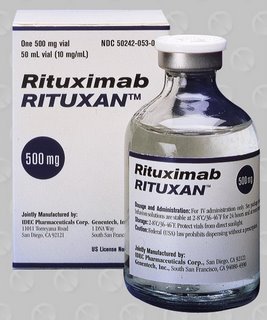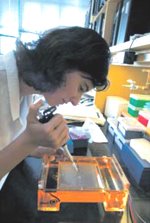 I've recently learned that Rituxan – the miracle drug that likely played a large role in the successful treatment of my cancer – has just been approved by the FDA for even wider use.
I've recently learned that Rituxan – the miracle drug that likely played a large role in the successful treatment of my cancer – has just been approved by the FDA for even wider use.If I'm reading the Genentech company's press release correctly, Rituxan is now approved for use with another combination of chemo drugs other than CHOP: a drug cocktail known as CVP (cyclophosphamide, vincristine and prednisolone). This is for patients with follicular non-Hodgkin lymphoma – the indolent (or slow-growing) form of the disease. Rituxan is also now approved for follicular lymphoma patients whose disease is "stable," as well as for those relapsed patients who have already had treatment with CVP.
This news probably doesn't apply to me, personally, because my "diffuse mixed large and small cell" grading is considered to be an aggressive form of NHL (which means I'm already approved for treatment with Rituxan). But, I'm glad to know this medicine is now available more widely, to make a difference in the lives of others.
This is a typical illustration of how new drugs come to be available. When pharmaceutical researchers come up with a new formula that's likely to help patients, and have completed all the laboratory tests at their disposal, they must then engage in a lengthy process of testing on human subjects, a process known as "clinical trials." Clinical trials are typically divided into several phases.
 Phase one involves a handful of patients, who are monitored closely to make sure the new medicine is safe to give to humans. When it comes to cancer drugs, "safe" is a relative term. Many widely-used cancer treatments have harmful side effects. Ironically, some chemotherapy agents (including some of the ones I've received) are known carcinogens. This means the medicines themselves will cause cancer in a small percentage of people who receive them. Yet, this is an acceptable risk, because avoiding the drugs is statistically more likely to harm patients. (If, for example, a drug is 80% likely to put a lymphoma patient into remission, but will cause leukemia, down the road, in an unfortunate 3% of the people who receive it, those are pretty good odds.)
Phase one involves a handful of patients, who are monitored closely to make sure the new medicine is safe to give to humans. When it comes to cancer drugs, "safe" is a relative term. Many widely-used cancer treatments have harmful side effects. Ironically, some chemotherapy agents (including some of the ones I've received) are known carcinogens. This means the medicines themselves will cause cancer in a small percentage of people who receive them. Yet, this is an acceptable risk, because avoiding the drugs is statistically more likely to harm patients. (If, for example, a drug is 80% likely to put a lymphoma patient into remission, but will cause leukemia, down the road, in an unfortunate 3% of the people who receive it, those are pretty good odds.)Fortunately, Rituxan – unlike many of the old-line chemotherapy drugs – has only minimal side-effects.
If there are no significant ill effects in the first phase, the trial moves on to phase two, in which a somewhat larger group of patients receives the drug. Researchers monitor this group not just with regard to safety, but also in order to test the medicine's effectiveness. Often, there must be a control group, randomly selected from among the pool of clinical-trial participants. Because it would not be ethical to give sick people only a placebo (a harmless substance, of no medical value), the patients chosen for the control group typically receive another, fully-approved cancer medicine instead. Clinical trial participants don't usually know whether they are in the study group or the control group. Patients who volunteer for such studies know they may have as much as a 50% chance of not receiving the promising new medicine, but they're generally willing to take that risk – because a 50% chance of getting it through a clinical-trial study is better than the 0% chance they would have of receiving it, had they stayed out of the clinical trial.
 If phase two is successful, the researchers move on to phase three, in which the new product is tested on thousands of volunteers. If the medicine proves to be both safe and effective for a significant portion of this group, then it finally receives government approval for general use.
If phase two is successful, the researchers move on to phase three, in which the new product is tested on thousands of volunteers. If the medicine proves to be both safe and effective for a significant portion of this group, then it finally receives government approval for general use.Research continues, then, through phase four: follow-up studies that examine the long-term risks and benefits of the drug.
Clinical trials are the cutting edge of cancer treatment. That's the reason many patients – particularly relapsed patients, who are running out of other options – sometimes travel great distances to be part of them. They're especially appealing to the uninsured and the underinsured, because drug companies typically make the medicines available to test subjects for free. Typically, clinical trials – especially phase three trials – are simultaneously offered in a number of leading treatment centers around the country, and even around the world. The theory is that this puts the new medicines within reach of as large a number of patients as possible.
It's quite a process – and very costly for the pharmaceutical companies to go through. That's the reason each of my six Rituxan doses had a list price of $7,000 (although the price was somewhat reduced for me – as it is for most patients – through contractual agreements between my medical insurance company and the doctor). Thankfully, my medical insurance covered most of it.
Pharmaceutical research is big business, no doubt about it: but it's a business that, when everything is said and done, saves lives.
No comments:
Post a Comment